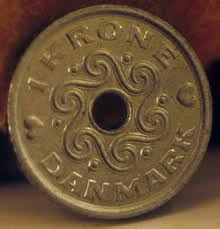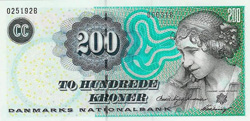|


The krone (sign: kr or ,-; code: DKK) is the currency of the Kingdom of Denmark. The krone is pegged to the euro via the European Union's exchange rate mechanism. The plural of krone is kroner. The krone is divided into 100 øre, the singular form being the same as the plural. The ISO 4217 code is DKK; the domestic abbreviation is "kr.". Occasionally, the variants DKR or Dkr are seen, but these are not official. The currency is sometimes informally referred to as the "Danish crown" in English (since krone literally means crown in the Danish language).
History
Until the late 18th century, the krone was a denomination equal to 8 mark. A new krone was introduced as the currency of Denmark in 1873. It replaced the Danish rigsdaler at a rate of 2 kroner = 1 rigsdaler. The krone was introduced as a result of the Scandinavian Monetary Union, which lasted until World War I. The initial parties to the monetary union were the Scandinavian countries of Sweden and Denmark, with Norway joining two years later. This placed the krone on the gold standard at a rate of 2480 kroner = 1 kilogram fine gold.
The name of the common currency was "krone" in Denmark and Norway (see Norwegian krone), and "krona" in Sweden (both names mean "crown" in English). After the dissolution of the monetary union, none of the three countries changed the names of the now separate currencies.
The Scandinavian Monetary Union came to end in 1914 when the gold standard was abandoned. Denmark returned to the gold standard in 1924 but left it permanently in 1931. Between 1940 and 1945, the krone was tied to the German Reichsmark. Following the end of the German occupation, a rate of 24 kroner to the British pound was introduced, reduced to 19.34 (4.8 kroner = 1 US dollar) in August the same year. Within the Bretton Woods System, Denmark devalued its currency with the pound in 1949 to a rate of 6.91 to the dollar. A further devaluation in 1967 resulted in rates of 7.5 kroner = 1 dollar and 18 kroner = 1 pound.
Faroe Islands and Greenland
In the Faroe Islands, Danish coins are used but the islands use distinct banknotes (see Faroese króna). During the British occupation of the islands in World War II, a shortage of small change occurred, which prompted the British to produce copies of Danish 1 øre, 2 øre, 5 øre, 10 øre, and 25 øre coins for use on the Faroe Islands, the first three in bronze, the latter two in cupronickel. This issue is identical to pre-war Danish coinage but carries the year 1942 and lacks the tiny heart identifying coins as products of the Royal Danish Mint in Copenhagen. No similar coins were issued this year in Denmark proper, as Denmark shifted to zinc issues this year. Banknotes in circulation in the Faroes were overstamped by the amt administration invalidating the notes outside of the Faroes.
The modern Faroese banknotes were introduced in the 1950s. Despite a common misconception, the Faroese króna is not an independent currency, but a separate set of DKK banknotes with a different design.
In Greenland, the colonial administration issued distinct banknotes between 1803 and 1968, together with coins between 1926 and 1964 (see Greenland rigsdaler and Greenland krone). In 2006, the governments of Denmark and the Greenland home rule authority announced that by 2008, distinct Greenlandic banknotes will be introduced. These will, like in the Faroes, have the status of a cosmetic variation of DKK banknotes. However, as of 2009, they are still not available, but are planned for distribution in 2011.
Due to this status, ordinary Danish banknotes are legal tender in both Greenland and the Faroe Islands, and Danish banks exchange notes issued for use in these regions 1:1 for ordinary Danish notes.
Relationship to the euro
Denmark negotiated special "opt-outs" of the Maastricht Treaty that allowed the country to preserve the krone while most other members of the European Union adopted the euro in 1999. A referendum on the currency issue held in 2000 rejected the proposed adoption of the euro. The Liberal-Conservative government of Anders Fogh Rasmussen planned another referendum on the issue in 2004, but these plans were dropped when polls showed decreasing support for the euro.
The krone is pegged to the euro via the ERM II, the European Union's exchange rate mechanism. Before the introduction of the euro, the krone was linked to the German mark, the intention being to keep the krone stable.
Coins
The coins of the krone currency are issued by the Danish National Bank. When the currency was introduced in the 1870s, coins were minted in denominations of 1, 2, 5, 10, and 25 øre; and 1, 2, 10, and 20 kroner. The 1, 2, and 5 øre were minted in bronze; the 10 and 25 øre, 1 and 2 kroner in silver; and the 10 and 20 kroner in gold. Production of gold coins ceased in 1917, followed by silver coins in 1919. Iron replaced bronze in 1918 and 1919. In 1920, cupro-nickel 10 and 25 øre were introduced, followed, in 1924, by aluminium-bronze ½, 1, and 2 krone coins.
In 1941, zinc 1, 10, and 25 øre and aluminium 2 and 5 øre coins were introduced, with zinc 2 and 5 øre following the next year. The ½ krone denomination was withdrawn due to lack of metal, and the 2 krone coin was not struck during the years of German occupation. Cupro-nickel 10 and 25 øre coins were reintroduced in 1946, followed by aluminium-bronze 2 krone coins the next year. In 1960, the 5 krone coin was introduced and the production of 2 krone coins ceased. 1 and 2 øre coins were withdrawn in 1973 , and 10 krone coins were introduced in 1979. 5 and 10 øre coins were withdrawn in 1989 and are no longer legal tender. Between 1989 and 1992, 50 øre, 2 and 20 krone coins were introduced, and in 2008 the 25 øre ceased to be legal tender.
The decision to withdraw the 25 øre coin, which went in effect on 1 October 2008, was made due to high costs of production, and a lack of purchasing power for the coin. It is possible to exchange it at the Danish National Bank until the 1st of October 2011.
Banknotes
In 1875, the National Bank introduced denominations of 10, 50, 100, and 500 kroner, with 5 kroner following in 1898. From 1891, a number of private banks issued notes, including the Aalborg Kreditbank, the Aarhus Kreditbank, the Dansk Købmandsbank, the Esbjerg Kreditbank, the Fredrikshavn Kreditbank, the Hjørring Kreditbank, the Odense Kreditbank, the Randers Kreditbank, the Thisted Kreditbank, the Varde Kreditbank and the Vejle Kreditbank. Denominations included 10 and 25 øre, 1, 2, 5, 10, 20, 25, and 50 kroner.
In 1914, 1 krone notes were introduced due to the outbreak of the First World War and were issued until 1921. In 1945, the Allied Command issued notes for 25 øre, 1, 5, 10, 50, and 100 kroner.
5 krone notes were replaced by coins in 1960. The next new denomination was not introduced until 1972, when production of 1000 krone notes began. In 1979, the 10 krone note was replaced by a coin and 20 krone notes were introduced, although these have since also been replaced by coins (both are, however, still legal tender).
In 1997, a complete new series was issued ranging from 50 to 1000 kroner. During 2002-2005, additional security features were added.
The text on this page has been made available under the Creative Commons Attribution-ShareAlike License and Creative Commons Licenses
|
